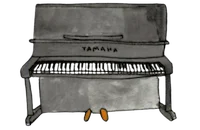Yamaha GC1 Baby Grand Piano Review & Information

OUR QUICK OPINION: The Yamaha GC1 is a better piano than the Yamaha GB1 and better than the vast majority of baby grand pianos out there. If you don’t have the space for a Yamaha C3 or C5, then the GC1 could be a perfect option for you. If you have any technical info or corrections for this article, please email mgpianos@gmail.com.
Is the Yamaha GC1 too small?
The GC1 is 161cm long, 149cm wide and weighs 290kg. This puts it at 10cm longer than the GB1 which will certainly help it produce a good tone in the bass. So if you have already decided against the GB1, well done, you should certainly consider something longer. Remember, longer is always better when it comes to grand pianos.
So no, the GC1 isn’t too small to produce a good sound BUT please check if you can fit a C2 or the lush sounds of a C3 in first (no musician ever regrets upgrading to a C3). Please also read on to discover the differences between the GC1 and the C1 (the GC1 is a slightly reduced version of the C1).
Here is a 2005 Yamaha GC1 of ours as demonstrated by Oliver. Our recording equipment has made it sound brighter than it was in real life. It has a lovely sweet and mellow tone.You can hear the tone quality of the GC1 in this cheeky excerpt from Tchaikovsky’s Romeo & Juliet
Forgive me for doing this to you, but I have to let you hear how a Yamaha C5 grand sounds by comparison. Here goes:
I showed you that video to encourage you to embrace the fact that longer grand pianos produce a better sound. You may not have space for a C5 but hopefully, this helps persuade you not to go for anything smaller than a GC1 if possible.
Where is the Yamaha GC1 made?
The GC1 is made in Hamamatsu, Japan which is Yamaha’s premier facility where they make many of their very best pianos such as the CFX concert grand piano and the famous Yamaha U3 uprights and other similar high-end uprights.
Brand New Price for a Yamaha GC1
The 2021 RRP is somewhere around the £14,000 mark depending on the colour and finish that you buy. You should expect to save at least 30-40% off that price by buying a little-used or properly reconditioned used version. Most baby grands are well-cared for and little-used so looking at used or reconditioned options is a great idea.
What do piano players think about the GC1?
Online reviews for the Yamaha GC1 are always very positive. Here is a couple I found.
From the Pianoworld.com forum
“The GC series is fine for typical home use. I’ve had a GC1 for a year now, and no issues whatsoever, a very high-quality product for an entry-level Yamaha.”
And here is an opinion from the Pianostreet.com forum
Forum user: (source)
“The GC1 is a fantastic piano and I was looking to buy one of them, a GB1 or a C1 a month ago. However… I did like the GC1 better than the C1!!! It is a fantastic piano.
What Our Customers Have to Say About the GC1
We sold a Yamaha GC1 to Mrs Kojs a few years and in her feedback she says:
“Thank you so much Mark! Fabulous piano which I love to bits! Great sound and looks absolutely pristine, I am the envy of all my friends.”

The Yamaha GC1 is better than…
In my opinion the GC1 is better than a Yamaha GB1 (10cm shorter than a GC1) or any other baby grand made in China or Indonesia both in terms of build quality, tonal production and definitely in terms of holding its value for many years. Japanese-made pianos represent a really strong combination of high build quality and sensible price. Avoid the temptation to go for the Chinese piano made “in collaboration with a German designer using German parts”.
What are the main GC1 and C1 differences?
The GC1 is the same underlying piano as the C1 (aka G1, C1L) but with some features removed or simplified to help keep the price down. Here are some of the main differences according to this video
- The C1 has a lock and the GC1 does not.
- The C1 has reinforced hammers heads with several layers of felt. The GC1 has 1 type of felt.
- The C1 has a solid wood keybed. The GC1 keybed is made from plywood.
- The C1 pedals bolt to a steel beam that stretches the full width of the piano. The GC1 pedals are bolted directly to plywood
So the GC1 is the same basic beast as the C1 but with a less refined finish and a couple of corners cut. This helped Yamaha sell the GC1 for around £6000-£8000 less than a C1. It’s up to you to decide if you think that is a good saving.
You can see the above differences highlighted in the following video
What other models should I consider?
Yamaha C2, C3 (or even C5)
Take a long, hard look at the size of your budget and music room. Are you SURE that you can’t stretch up to a Yamaha C2 (also known as the G2, C2L, C2X) at 173cm long or (dare I say it, will you forgive me?) give yourself a really special treat and try to squeeze a Yamaha C3 (also known as the G3, G3L, G3X) into your music room. The C3 is 186cm which means it is the first of Yamaha’s grands to be over 6ft in length and this really gives a lovely “purr” and sometimes a full-on “growl” in the bottom couple of octaves. Ooh, wait, can you fit in a C5? It’s a big old beast but worth a quick measure up.
Yamaha U3
If space is the deciding factor about your decision to consider a GC1 and you really can’t upgrade to a C2 or similar, you might be interested to know that the Yamaha U3 (and other 131cm tall uprights) has longer bass strings than a GC1 and other baby grand pianos. So perhaps give the Yamaha U3 a quick consideration, too.
Do you have a GC1 to sell?
If you are looking to sell your Yamaha GC1 baby grand piano, please email details to mgpianos@gmail.com and we will either make a cash offer or perhaps we can sell it on your behalf in our showroom.
Conclusion
The GC1 is a very good baby grand piano and is definitely a step up from a GB1 and almost all other baby grands. As noted, the customers who have bought this model from us are always happy. If you are looking for the best performance possible and you don’t mind paying extra, the size and money however, there are some similar models, as we have mentioned, that will do the job better.
Questions? Please email mgpianos@gmail.com
Thanks for your time
Mark








